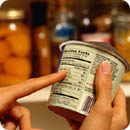
How can I tell if a food contains trans fat? Even though trans fats are bad for your health, and about 40% of processed foods on supermarket shelves contain them. To help consumers reduce the amount of trans fat in their diets, the Food and Drug Administration (FDA) required food companies to list the grams of trans fat that a food contains on the Nutrition Facts label. This requirement began in January 2006. How can a food list zero grams of trans fat on the label, but still contain partially hydrogenated oil in its ingredients? Currently, the FDA's label regulations state that when one serving of a product contains less than 0.5 grams of any nutrient (including trans fat), then the amount is considered nutritionally insignificant and can be expressed a "0 grams" on the Nutrition Facts label. So in this case, the product contains less than 0.5 grams of trans fat per serving. If the word "hydrogenated" appears in the Ingredients list, does that automatically mean that the food contains trans fat? Not always. "Partially hydrogenated" oils DO contain some amount of trans fat, but fully "hydrogenated" oils become predominantly saturated fat and do NOT contain trans fat. These fats are included in the saturated fat listing on the Nutrition Facts label. Do restaurant foods contain trans fat? While food companies are required to list trans fat on their labels and are working to find healthier substitutions, the restaurant industry has not received the pressure to change. Many restaurants prefer to fry their foods using partially hydrogenated oils, resulting in a high trans fat content in the food. For now, the best way to avoid trans and saturated fats when dining out is to skip the fried foods, including French fries and all fried vegetables, fish, seafood, chicken, appetizers, and pastries. You can also ask for an ingredients list and find out what kind of oil is used for frying or cooking. Some restaurants that voluntarily list their nutrition facts online or in print also include trans fat contents of their foods. Is there a guideline or limit on how many grams of trans fat we should consume? Although scientific reports have confirmed a relationship between trans fat and an increased risk of coronary heart disease, researchers have not yet established a reference value for trans fat. Instead, they are advising consumers to eat as little trans fat as possible. When comparing foods at the store, choose the food that is lower in saturated fat, trans fat, and cholesterol. But you can still have your cake, eat it, and have a healthy heart too. Just avoid products that list partially hydrogenated vegetable oil or shortening as an ingredient. Your heart will thank you! |
Translating those Trans Fats
Understanding and Avoiding these Unhealthy Fats
‹ Previous Page Page 2 of 2






Member Comments